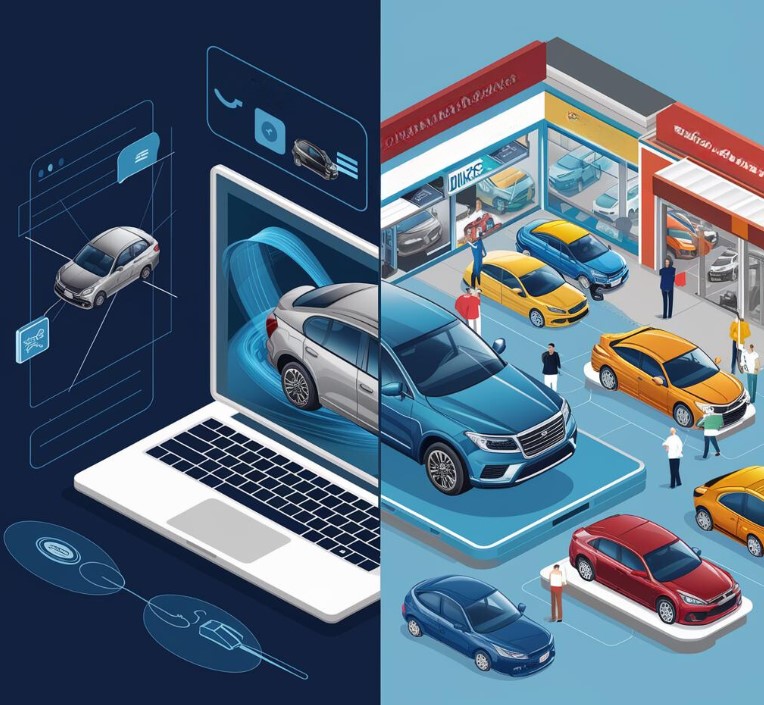The experience of purchasing a vehicle can be an emotional journey, filled with excitement, anticipation, and sometimes even anxiety. Picture this: a parent eagerly planning to buy their child their first car, recalling their own memorable days of freedom behind the wheel. The open road symbolizes both adventure and responsibility.
In a world where technology permeates daily life, car shopping now presents two distinct paths: the convenience of online vehicle shopping and the traditional dealership experience. Each option offers unique benefits that appeal to various preferences and priorities.
A recent Cox Automotive survey highlights a significant shift in consumer & Car Buying behavior, with 68% of car buyers aiming to conduct the majority of their purchasing process online in the future. As this digital wave crashes against long-standing traditions, making an informed choice becomes essential for navigating the complexities of today’s e-commerce automotive landscape.
The Shift in Car Buying Preferences
The preferences of consumers in car buying are shifting significantly, driven by convenience and new purchasing options. A notable change is evident in the rise of online vehicle shopping, allowing consumers to explore their choices without leaving their homes. This model offers a refreshing alternative to the traditional dealership experience.
The Rise of Online Car Buying

Platforms specializing in online vehicle shopping, such as Carvana and Vroom, are reshaping the market. These services provide a streamlined process for remote car sales that emphasize user-friendly interfaces and comprehensive internet inventory. Customers can browse a variety of models, read detailed descriptions, and even schedule deliveries—all from their living rooms. The flexibility of contactless car buying has made it increasingly appealing, particularly for busy individuals who value efficiency.
Impact of the Pandemic on Buying Trends
The COVID-19 pandemic catalyzed an exploration of contactless car buying. Traditional dealerships quickly adapted, offering online inventory views and virtual consultations. This transition allowed customers to shop for vehicles without needing physical interaction. With surveys revealing a preference for remote transactions, it’s clear that the pandemic accelerated a trend likely to persist. Younger generations, particularly millennials and Gen Z, embrace the ease and accessibility of remote car sales, proving that convenience plays a crucial role in modern purchasing behaviors.
| Trend | Description | Influencing Factors |
| Rise of Online Vehicle Shopping | Consumers increasingly prefer to browse and purchase cars online. | Convenience, user-friendly platforms, and expanded options. |
| Adoption of Remote Car Sales | Dealerships offering virtual tours and home delivery options. | COVID-19, technological advances, changing consumer preferences. |
| Emphasis on Contactless Car Buying | Ability to complete transactions without physical interaction. | Health concerns, desire for efficiency, focus on safety. |
Advantages of Online Car Buying
Online car buying presents a range of advantages that cater to the modern consumer’s needs and preferences. As digital car purchasing becomes increasingly popular, many individuals are discovering the benefits of this new approach compared to traditional dealerships.
Convenience and Comfort
The ease of online vehicle shopping allows buyers to explore their options from the comfort of their homes. This eliminates the need to visit multiple dealerships, ensuring a more efficient and less stressful experience. Consumers can browse listings at their own pace, fitting the process into their schedules without time constraints.
Expanded Options and Comparisons
Access to a vast selection of vehicles across multiple platforms enhances the online car buying experience. Buyers can easily compare prices, features, and availability from a wider range of dealerships and private sellers than what a single physical location offers. This ability to efficiently assess options leads to informed decision-making and potentially better deals.

Satisfaction with the Online Process
Data shows that satisfaction rates for those engaged in remote car sales significantly surpass those who opt for traditional methods. Many online buyers report feeling more empowered and less pressured, enjoying a more personalized shopping experience that aligns with their preferences. This shift has resulted in a notable increase in customer happiness regarding the car buying journey through online channels.
Disadvantages of Online Car Buying
Online car buying offers a convenient and extensive platform for purchasing vehicles, but it has notable drawbacks. Understanding these disadvantages can help potential buyers make informed decisions.
No Physical Inspection or Test Drive
One of the primary concerns with internet car buying is the inability to physically inspect or test drive vehicles before purchase. This lack of hands-on experience can lead to dissatisfaction, as buyers may miss critical issues related to the car’s performance, comfort, and overall feel.
Limited Negotiation Opportunities
Many online platforms function on a no-haggle basis, which restricts negotiation possibilities. This can be a drawback for those who are accustomed to bargaining and might feel that the prices offered do not reflect the true value of the vehicle. Understanding the online car buying pros and cons is essential for managing expectations during the purchase process.
Potential Extra Fees
Buyers may encounter additional fees in car buying that were not initially anticipated. Costs such as delivery charges, registration, and handling can escalate overall expenses and lead to budget overruns. These unexpected financial burdens may diminish the appeal of buying a car online.
Benefits of Traditional Dealerships

Many consumers continue to find value in traditional dealership experiences, enjoying several specific benefits that online platforms may lack. The ability to interact with vehicles directly often leads buyers to feel more confident in their purchase decisions.
The Ability to Test Drive and Inspect Cars
One of the significant car test drive advantages is the firsthand experience it offers. By visiting a dealership, buyers can physically inspect the cars in detail. This opportunity allows them to verify the vehicle’s condition and performance. A test drive enables potential buyers to evaluate handling, comfort, and overall driving feel, ensuring that the selected car meets their expectations before committing to a purchase.
Room for Negotiation and Incentives
Another appealing aspect of traditional dealerships is the potential for negotiation at dealerships. Sales representatives often have some flexibility in pricing, which can lead to favorable deals for buyers. Negotiating can result in cost savings or additional perks such as warranty extensions or maintenance packages. Additionally, many dealerships offer promotional incentives that may not be available through online buying channels, further enhancing the attractiveness of choosing this route.
| Benefit | Traditional Dealerships | Online Platforms |
| Test Drive | Available; allows for real-time assessment | Not available; relies on descriptions and reviews |
| Inspection | Physically inspect the vehicle’s condition | Limited; may rely on photos and descriptions |
| Negotiation | Potential for price negotiation | Often fixed pricing; minimal negotiation |
| Incentives | Offers promotional financing and rebates | Limited options; primarily independent sellers |
Related Posts:
- 20 Best Gaming Headset Under 50$ 2024 - for PC, PS4,…
- 15 Best Shoes for Walking on Concrete 2024 - Soft &…
- Top 10 Best Office Chair Under 200 2024 - Ergonomic…
- Top 10 Best Modem For Gaming 2024 - For Optimum Gaming Speed
- 12 Best Car Wax For Black Cars 2024 - Protection and…
- 13 Professional Bike Water Bottle Holder 2024 - Top…







